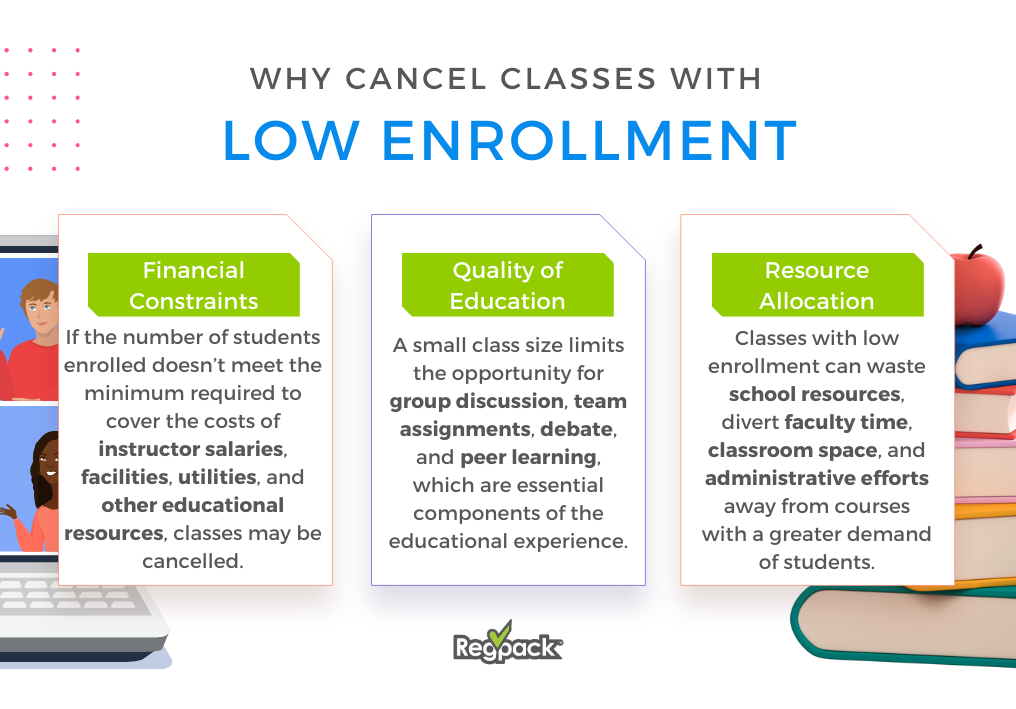The journey from course planning to actual classroom learning is filled with unexpected twists and turns. Sometimes, it leads to the decision to cancel a class. This decision could stem from various reasons such as scheduling conflicts, unforeseen emergencies, university closure, or instructor availability issues, but one prevalent cause is low enrollment. When classes are canceled, it’s not just the school schedules that are thrown off – the student’s academic paths are also impacted, often requiring them to adapt and change their plans.
This situation, while challenging, opens up the discussion on the importance of adaptability, effective management of resources, and the commitment to delivering high-quality education. Whether you’re a teacher, student, or advocate for effective learning environments, understanding the reasons behind class cancellations and exploring the potential solutions offers valuable perspectives on making education more accessible and rewarding for everyone involved.
Regardless of whether your education is being delivered through online classes or face-to-face, it’s important to establish clear strategies and procedures to soften the blow of class cancellations due to low enrollment. This not only helps manage the immediate effects but also helps preserve the continuity of education for students.
Why Cancel Classes with Low Enrollment?
Deciding to cancel a class due to low enrollment is never an easy call to make. While the immediate assumption might be financial, the implications extend far beyond the balance sheet. Canceling a class touches everything from the quality of education students receive, to how well the school uses its resources and even the effectiveness of the learning environment as a whole. The decision to cancel a class is made with these priorities in mind, aiming to serve the best interests of everyone involved while maintaining the school’s standards and goals.

Financial Constraints
Financial constraints are a primary consideration in the decision to cancel classes with low enrollment. It costs a university quite a bit to offer a class, considering expenses like instructor salaries, facilities, utilities, and other educational resources. If the number of students enrolled doesn’t meet the minimum required to cover these costs, the class may be canceled. Maintaining financial health and allocating resources wisely is important for the institution’s ability to provide quality education across all its programs.
Quality of Education
Low enrollment can also affect the quality of education. The educational experience is significantly enhanced by the presence of a diverse and engaged student body. Low enrollment compromises this dynamic. A smaller class size limits the opportunity for group discussion, team assignments, debate, and peer learning. Plus, faculty members can provide more personal attention in a class with adequate enrollment. Because of this, classes might be canceled to prioritize the maintenance of a high-quality learning environment that benefits both students and faculty members.
Resource Allocation
To manage schools efficiently, it’s important to make sure resources are being utilized most effectively. Classes with low enrollment can waste these resources, diverting faculty time, classroom space, and administrative efforts away from courses with a greater demand. By canceling these classes with low enrollment, schools can reallocate these resources to areas with higher student interest. This might mean they can start new courses that a lot of students are interested in or improve the popular ones they already offer. This ensures that you remain responsive to student needs and optimize offerings for a larger segment of the student population. This forward-thinking approach is good for budget and planning and helps it grow and adapt to changes in what students want to learn.
Steps for Cancelling a Class

When a decision is made to cancel a class, it’s important to take several steps to mitigate the impact on students. By carefully following these steps, you show your dedication to prioritizing students’ needs:
1. Evaluate Your Options: As the registration period ends, teachers together with the administration, assess individual class enrollment numbers. Previous data and analytics are often used here to predict whether late registrations will be enough to boost the numbers to a workable level.
2. Consult Administration: If enrollment numbers fall short of the required minimum, a consultation process begins. Here, the administrative staff members and department heads gather to discuss the class cancellation. It’s a collaborative effort to explore all possible options before deciding to cancel.
3. Send Timely Notifications: Once the decision to cancel is made, the priority shifts to informing affected students in a timely manner. A class cancellation notice is created to provide clear information about the reasons for cancellation, emphasizing that the decision was made with their best educational interests in mind. The notification should be sent through multiple channels— email, the school’s home page, text alerts, and even direct phone calls for a personal touch—to ensure the message reaches all students. The timing is critical; it should be done as soon as possible to minimize disruption to students’ academic plans and give them plenty of time to adjust.
4. Provide Refunds: The cancelation policy should outline the procedure for processing refunds for a canceled class. Schools may offer a full refund of any fees paid towards the canceled class or apply these funds to the student’s account balance. Clear communication of the refund policy should be provided to students about the timeline for their refund or account adjustment, the amount they can expect to receive, and any other required actions on their part, such as submitting a refund request form within a specified number of days.
5. Offer Course Alternatives: Providing course alternatives is crucial to help students stay on track with their academic goals. The staff member or academic advisor responsible for this process works closely with students to understand their individual needs and academic requirements. This process also helps increase the enrollment for the other courses you offer.
How Regpack Can Assist with Course Management
Regpack, an online registration software, offers robust solutions to aid in managing the complexities surrounding class cancellations due to low enrollment:
Boosting Enrollment
Regpack uses advanced technology to make the registration process as seamless and user-friendly as possible, thereby appealing to a wider student base. By making the registration process more accessible, Regpack can help increase class enrollment numbers.
Ease of Registration
The platform’s intuitive design simplifies the registration process, minimizing frustrations and drop-offs. Regpack offers an automated system that guides students through each step, from initial interest to final enrollment. This process not only improves the user experience but also encourages higher enrollment rates, as students can easily find and register for classes that meet their educational goals.
Efficient Communication
Effective communication is key when managing courses, especially if you need to cancel a class. Regpack facilitates direct and efficient communication with students, making sure they get all messages on time, whether they are reminders, updates, or cancellation notices. Customizable templates allow for the personalization of messages, ensuring clarity and maintaining a positive connection with students.
Refunds Made Easy
Handling refunds is a sensitive aspect of class cancellations that can significantly impact student satisfaction and trust. Regpack simplifies this process with a straightforward system for managing refund requests. It automates the assessment of eligibility for refunds according to the institution’s policy, processes transactions securely, and quickly updates how much money is in a student’s account.
Advanced Course Management Features
Beyond addressing the immediate needs of class cancellations, Regpack offers advanced features for managing courses better. Its reporting tools offer insights into enrollment patterns, class performance, and student feedback, enabling proactive adjustments to course offerings and marketing strategies.
By using Regpack for your course management, you can experience a more streamlined, efficient, and responsive system. Regpack helps increase student sign-ups by making registration easier, keeping communication clear, and making giving refunds simple. Its capabilities not only ease the logistical challenges of course management but also enhance the overall educational experience for both students and administrators.
Navigating Class Cancellations and Enhancing Course Management
Canceling classes due to low enrollment requires careful planning, clear communication, and a student-centered approach. By understanding the reasons behind these decisions—such as cost-effectiveness, educational quality, and efficient resource allocation—you can make informed choices that serve both your interests and those of your students. The steps involved in canceling a class, from evaluating options to offering course alternatives, show how important it is to reduce any negative effects on students.
With the help of tools like Regpack, you can not only manage the immediate challenges of class cancellations but also get better at organizing your courses. This means you can have a smoother, more adaptable, and better educational experience for everyone.


















